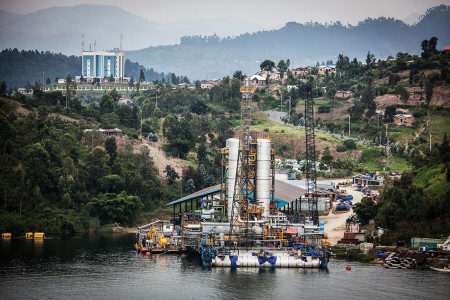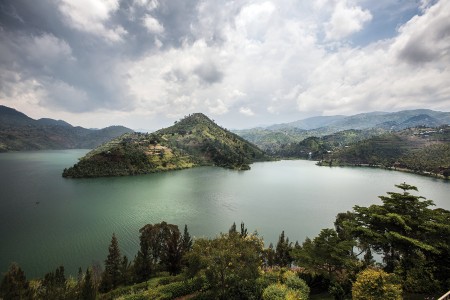April 16, 2015 – What will stop humanity from continuing to pursue energy sources, even those that pose a great risk to the planet? It doesn’t seem too far fetched to say, “almost nothing.” Canadian energy companies continue to process bitumen even though the intensive nature of production contributes a significant amount of climate changing greenhouse gases. Energy companies in the Arctic continue to send drilling rigs into areas where a single accident could lead to centuries of damage to the fragile ecology of the polar seas. Japanese energy companies are trying to tap methane hydrates on the sea floor to the east of Tokyo Bay knowing that this highly volatile energy source could be instrumental in setting off ocean landslides and tsunamis. Brazil continues to tap deepwater oil sources even though experiencing leaks from the well sources at the ocean floor. Now add to this the latest human pursuit of energy, trying to tap methane gas trapped in deep water lakes in Central Africa.
The lakes of Africa have been a source of calamity in the past. In 1986 in Cameroon, Lake Nyos experienced an eruption of gas from deep in the lake. It was carbon dioxide and the cloud that rose to heights of 100 meters spread from the lake surface to the surrounding shores and as far away as 25 kilometers from the lake itself. The cloud killed 1,700 people, many in their sleep.
Lake Kivu, (seen above) located between Rwanda and the Democratic Republic of the Congo (DRC) has gas trapped in deep water. But unlike Lake Nyos there is more here than carbon dioxide. There is methane, which if it bubbles to the surface in the same way it happened at Lake Nyos would kill millions in the densely populated surrounding countryside. Lake Kivu is a bomb waiting to go off. But that isn’t stopping energy companies from seeing if they can ride the bomb and generate power for both Rwanda and the DRC. The energy companies know that the tapping of the lake could precipitate a massive release of both gases. But what the heck, the risk in the minds of both government and energy companies seems worth it.
How did the gases get trapped at the bottom of the lake? Lake Kivu sits in an active volcanic zone. The surrounding volcanoes produce lots of vented gas that percolates the groundwater and eventually finds its way into the lake. And because the water is mineral rich it feeds the life within the lake which when it dies or produces waste rains down to the lake bottom where bacterial blooms generate even more gas. Only the deepness and weight of the water column above the gas holds it in place. How much gas? Estimates are 60 billion cubic meters of methane and 300 billion of carbon dioxide.
The energy companies want to extract both gases returning the carbon dioxide to the deep lake. So far pilot projects have worked with no major incidents. If these can be scaled the potential gas resource would boost both countries electrical generation capacity, helping to speed up development and modernization.
Lake Kivu’s surroundings are not ideal for any energy company to try and do what is being attempted here. The active volcanoes feed vast amounts of gas into the subsurface with much of it finding its way into the deepest water in the lake. That means the volume of gas is changing. And there is evidence of five past eruptions where the lake’s water was literally turned over by sudden destabilization of the trapped gas. These eruptions were spread over the last 6,000 years. What probably caused them – an earthquake or volcanic eruption. Now add an overzealous energy company trying to tap the gas ad we could see a third cause that would lead to a gas cloud 100 meters high encompasssing the lake and surrounding country.
A small scale pilot project, testing the technology to be deployed, is currently underway. Called KivuWatt, it involves the placing of a barge (see the image below) offshore in the middle of the lake where it will draw water from 350 meters in depth. As the water rises the methane and carbon dioxide will bubble out. The gas will then be siphoned off while the remaining water is returned to the deep lake. The gas mix, 80% methane and 40% carbon dioxide will then be further treated to remove as much of the latter as possible. The process will employ water drawn from 40 meters below the surface which then will become saturated with carbon dioxide before being reinjected into the lake to depths below 60 meters. The end product will be 85% methane gas which will then be compressed and piped to an onshore power plant.
Any one of these process steps, whether extraction or reinjection, could upset the lakes stratified water layers. And once the gas starts to leak upward where there is less pressure there will be nothing to stop it from rising to the surface.
That says nothing about the danger to the protein food sources that locals harvest from the lake. Since the current small scale project started up the harvesting of sambaza, a local sardine, has declined dramatically. The correlation cannot be ignored although researchers have yet to point to a specific smoking gun.
One wonders why Rwanda and the DRC are not looking at renewable energy alternatives rather than playing with what could become another Lake Nyos story. The DRC alone has identified 780 potential hydro sites within its borders. Rwanda as well has plenty of latent hydro capacity. And both countries show potential to implement significant wind, solar and geothermal energy projects. Yet instead they have chosen to tempt fate – trying to exploit a methane bubble trapped under a water column in a volcanic lake. One mistake and Lake Kivu could explode making the Lake Nyos disaster look like a sideshow. Where Lake Nyos saw 1,700 die, Lake Kivu could see millions of victims.










